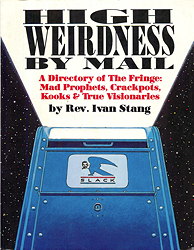Bananas
Selling sad produce
In grocery stores, fresh produce such as bananas and tomatoes often goes to waste if it's become a "loose single." Shoppers think it's damaged or imperfect.German researchers have come up with a way to address this problem: make shoppers think the produce is feeling sad because it hasn't been bought.
This is achieved simply by displaying an anthropomorphized picture of sad produce above the singles.

The produce has to be sad. Happy fruits and vegetables don't motivate shoppers.
Also, making produce sad works better than offering a price discount, because shoppers often assume discounted food must be bad.
More info: Anthropomorphic Sad Expressions Reduce Waste of 'Single' Imperfect Food
via Book of Joe
Posted By: Alex - Thu Dec 12, 2024 -
Comments (2)
Category: Food, Fruit, Bananas, Advertising, Experiments, Psychology
A stereo for 299 bananas
I posted a month ago about a case from 1965 in which a car dealer advertised, and then had to sell, a new Pontiac sedan for "1,395 bananas."Turns out this isn't the only time a merchant has run into trouble using the word 'bananas' as slang for 'dollars.'
In 1986, the discount electronics chain Silo ran a TV ad offering a new stereo system for only "299 bananas." Thirty-five people showed up with the appropriate number of bananas, expecting to get a stereo. The store gave 33 of them stereos, and credited the other two for the cost of the bananas.
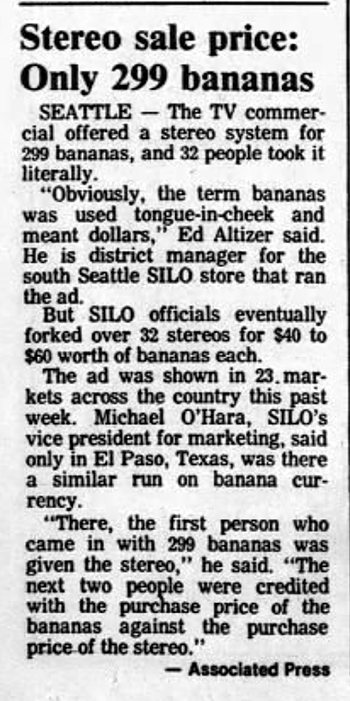
Lafayette Journal and Courier - May 1, 1986
For more info, check out this article on the Priceonomics blog. It notes that Silo ended up stuck with around 11,000 bananas that they had to get rid of:
Posted By: Alex - Fri Sep 17, 2021 -
Comments (0)
Category: Business, 1980s, Bananas
Banana Label Collecting
Banana-label collecting is not only a thing. It has an active community of collectors.One of the top collectors is Becky Martz who now has over 22,630 labels. She's archived them at her website, Becky's Gone Bananas.

You can also check out the BananaLabel Catalog of the Produce Real Society. There's not many labels to see on their website, but they sell a master catalog of 31,000 labels going all the way back to 1913.

Posted By: Alex - Thu Sep 16, 2021 -
Comments (5)
Category: Collectors, Bananas
Banana-Shaped Writing Device
Kia Scudder of San Antonio, Texas was recently granted Patent No. 11077701 for a "banana shaped writing device and method." From the patent:

Posted By: Alex - Fri Sep 03, 2021 -
Comments (2)
Category: Inventions, Patents, Bananas
Miss Banana-Matic
The Continental/Moss-Gordin Banana-Matic could ripen, store, and display bananas in a controlled atmosphere "thus eliminating spoilage loss."In 1967, Linda Gipson of Pensacola, Fla. had the honor of being named 'Miss Banana-Matic'.

Prattville Progress - Apr 17, 1967
Posted By: Alex - Mon Aug 23, 2021 -
Comments (2)
Category: Awards, Prizes, Competitions and Contests, 1960s, Bananas
International Banana Museum
The International Banana Museum, in Mecca, CA, boasts that it's the home of "25,000 banana-related items and pictures."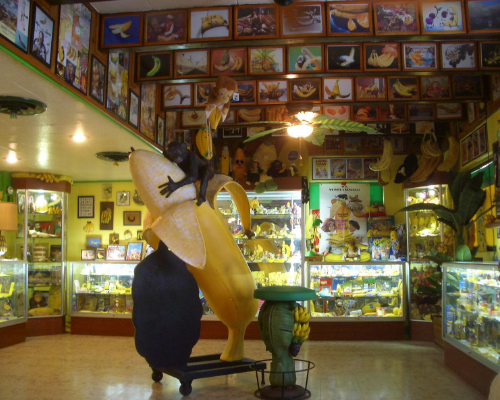
I think the location of the museum is odder than the idea of the museum itself. Mecca is just a tiny desert community located at the northern tip of the Salton Sea. No bananas grow anywhere near it.
The California Curiosities site explains how the museum ended up being there: because the owner of the museum, Fred Garbutt, saw a collection of banana memorabilia for sale on eBay and figured that a banana museum might generate some publicity for his struggling liquor store.
Posted By: Alex - Sat Aug 21, 2021 -
Comments (5)
Category: Museums, Bananas
Car sold for 1395 bananas
1965: Bernice Wyszynski saw a brand-new Pontiac sedan advertised for "1,395 bananas". So she tried to take the dealer up on that offer. However, the dealer insisted that the car actually cost $1,395. 'Bananas', he said, was a vernacular term for dollars. Wyszynski threatened to sue him for false advertising, and eventually he relented, selling her the car in exchange for 1,395 bananas.I can buy five bananas at the supermarket for $1. Which means that, in present-day money, Wyszynski got the car for around $280. That's a pretty good deal.
Bernice Wyszynski died in 2003, and the banana incident made it into her obituary:

Long Beach Press-Telegram - May 5, 1965

Arizona Daily Star - May 1, 1965
Posted By: Alex - Tue Aug 10, 2021 -
Comments (8)
Category: Food, 1960s, Cars, Bananas
Banana Ganesh
Read all about it here.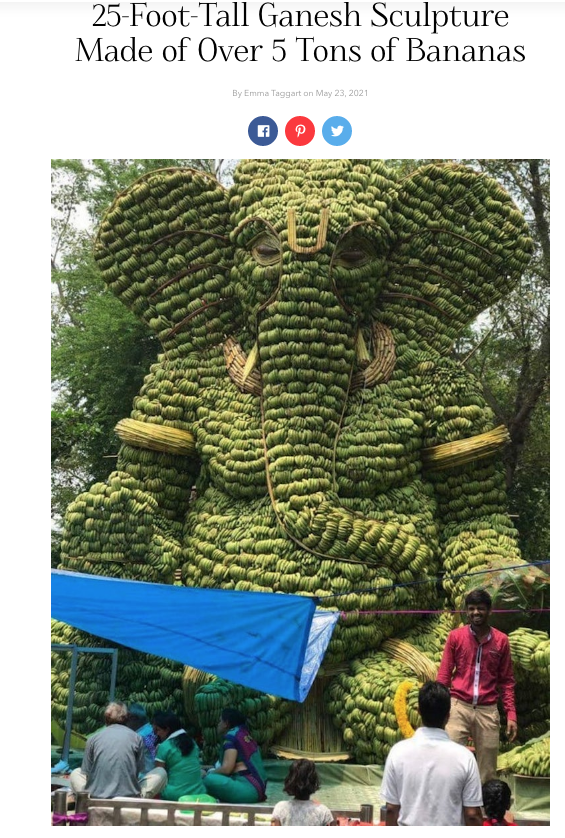
Posted By: Paul - Mon May 24, 2021 -
Comments (3)
Category: Animals, Art, Statues and Monuments, Food, Religion, Bananas
The Banana Bat
In the late nineteenth century, Emile Kinst decided that the game of baseball was too easy, so to make it more challenging he invented a curved bat which came to be known as the "banana bat". Obviously his invention never caught on. But Kinst made several hundred of these bats, and the few that are still around are quite valuable. The one shown below sold for $2880.
image source: goldin auctions
Bats have been the subject of brain cogitations by ambitious inventors. Some years ago the players became familiar with what was called the flat bat. This was never patented, but it showed the inventive genius of some player. This bat was made by shaving one of the round bats with a knife until a part of the bat near the end was flat. The object of this was to give the player a chance to bunt the ball by catching it a short clip...
There was another bat invented, however, and the man who originated it had such faith in his idea that he had it patented in 1890. This bat had a curve in it and was something like a lacrosse stick. According to the theory of the inventor, Emile Kinst, when the ball was struck by a certain portion of the bat, in addition to the regular flight produced by the blow the ball would receive a rotary motion more or less violent. The result was supposed to be a ball not only difficult to handle by the fielder if it were to come straight at him, but also hard to hold if it were a fly and he got under it, because of the spinning produced by the bat.
It was also designed to produce the effect of a bunt, but in a better way, for the inventor claimed his bat would cause the ball to land near the batter and stay there under certain conditions. With these results Mr. Kinst claimed that it would make the game more difficult to play, and therefore more interesting and exciting. But his hopes were not realized, for the bat never got the official sanction of the league.
Posted By: Alex - Thu Feb 04, 2021 -
Comments (1)
Category: Sports, Patents, Nineteenth Century, Bananas
Instant Bananas
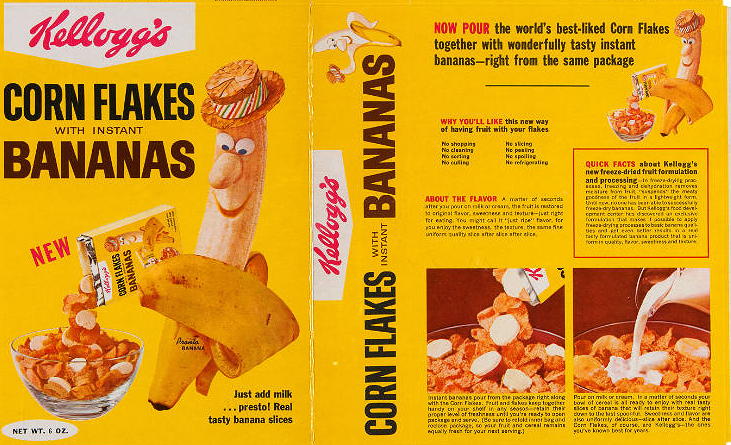
Scott Bruce and Bill Crawford offer some context in their book Cerealizing America: The Unsweetened Story of American Breakfast Cereal:
In 1966, Kellogg pulled the plug on Corn Flakes and Instant Bananas. "We tested the market carefully, we tried, we failed, and we're getting out of the market," Kellogg's Ken Englert told Consumer Advertising magazine. Without informing the star of their decision, Kellogg decided to move Durante over from Instant Bananas to Kellogg's main line, Corn Flakes. "Everything was kept quiet until Carl Hixon [a Burnett writer] and myself went to New York to shoot him in a couple of commercials for Kellogg's Corn Flakes," recalled commercial director Rudy Behlmer. "Suddenly he looks at the [story] boards and he says, 'Where are da bananas?' and we said, 'Well, Jimmy… this is without bananas,' and he said, 'No bananas, no Durante.'"
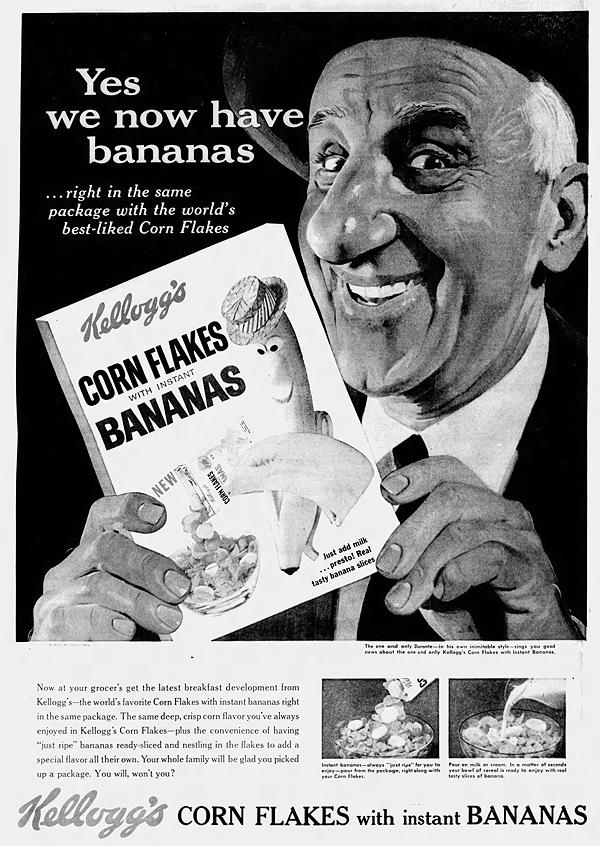
Wisconsin State Journal - Mar 24, 1965
Posted By: Alex - Thu May 07, 2020 -
Comments (3)
Category: Cereal, 1960s, Bananas

| Who We Are |
|---|
| Alex Boese Alex is the creator and curator of the Museum of Hoaxes. He's also the author of various weird, non-fiction, science-themed books such as Elephants on Acid and Psychedelic Apes. Paul Di Filippo Paul has been paid to put weird ideas into fictional form for over thirty years, in his career as a noted science fiction writer. He has recently begun blogging on many curious topics with three fellow writers at The Inferior 4+1. Contact Us |



